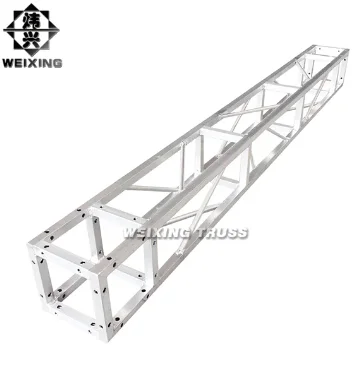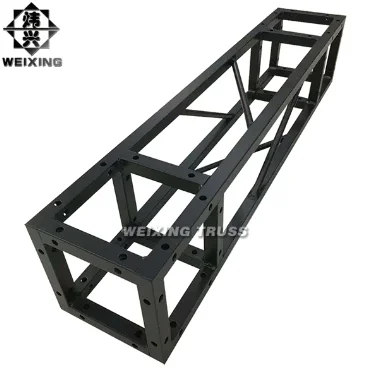Square tube trusses are a structural member widely used in various industries, including construction and event planning. Its unique design and numerous benefits make it a popular choice for applications requiring strength, stability and versatility. In this article, we will explore the design principles and advantages of square tube trusses.
Understanding Square Tube Truss Design
Basic Principles
Square tube truss design revolves around using square tubes to create a framework that supports loads. This design offers strength and stability due to the inherent properties of square shapes. Engineers utilize mathematical calculations to determine the optimal size and placement of square tubes within a truss.
Square tube trusses are widely favored for their efficiency in weight distribution, making them ideal for various structures such as bridges, roofs, and towers. They provide exceptional load-bearing capacity while minimizing material usage, resulting in cost-effective construction solutions.
Key Components
The key components of a square tube truss include the top chord, bottom chord, vertical members (posts), and diagonal braces. These elements work together to distribute forces evenly throughout the structure, ensuring structural integrity under different loading conditions.
Configurations of square tube trusses can vary based on specific project requirements. Engineers tailor the arrangement and sizes of components to achieve optimal performance while meeting safety standards. By adjusting factors like tube thickness and connection methods, designers can customize trusses for diverse applications.
Differentiation from Other Designs
Compared to other types of trusses like triangular or Pratt trusses, square tube trusses offer unique advantages. The symmetrical geometry of square tubes provides uniform resistance to bending forces along all axes, enhancing overall stability. In contrast, triangular trusses excel in efficiently transferring tension and compression forces but may not offer the same level of versatility in terms of load distribution.
Square tube truss designs also stand out for their aesthetic appeal in architectural applications where visual symmetry is crucial. Architects often leverage the clean lines and modern look of square tube trusses to create visually striking structures that blend functionality with design elegance.
Benefits of Square Tube Trusses
Durability and Strength
Square tube trusses are known for their exceptional durability and impressive strength, making them a reliable choice for various construction projects. The square shape of the tubes provides enhanced structural integrity, ensuring long-lasting support.
Square tube trusses can withstand heavy loads and adverse weather conditions due to their robust design. This durability translates to reduced maintenance requirements and increased safety over time.
Versatility and Aesthetic Appeal
One of the key advantages of square tube trusses is their versatility in applications. They can be used in a wide range of architectural styles and designs, offering flexibility in creating unique structures. Whether it's for residential, commercial, or industrial purposes, square tube trusses provide endless possibilities.
Moreover, square tube trusses also contribute to the aesthetic appeal of buildings. Their clean lines and modern look add a touch of sophistication to any structure. Architects often appreciate the sleek appearance that square tube trusses bring to their projects.
Cost-Effectiveness and Sustainability
Square tube trusses shine as an economical choice for construction projects. Their efficient use of materials results in lower overall costs without compromising on quality or performance. Builders find them budget-friendly while still delivering excellent structural support.
In addition to being cost-effective, square tube trusses are also sustainable options for environmentally conscious projects. By using less material compared to other types of trusses, they contribute to reducing carbon footprint during construction. This sustainability aspect aligns with the growing focus on green building practices.
Structural Integrity of Square Trusses
Load-Bearing Capacity
Square tube trusses exhibit exceptional durability due to their robust design and material composition. The load-bearing capacity of these trusses is unmatched, making them ideal for supporting heavy loads in various structures. The square shape provides a significant advantage by distributing the weight evenly across the entire structure, minimizing stress concentrations.
The reliability of square trusses lies in their ability to withstand immense pressure without compromising structural integrity. This reliability ensures that buildings and bridges supported by square trusses remain stable and secure even under extreme conditions. Engineers often prefer square tube trusses for projects requiring high strength-to-weight ratios, highlighting their reliability in critical applications.
Stability and Safety
Square tube trusses play a crucial role in ensuring the stability and safety of structures. By efficiently transferring loads to support points, these trusses prevent excessive deflection or deformation, maintaining the overall stability of the system. Their rigid construction minimizes sway and movement, enhancing structural safety during seismic events or strong winds.
The design of square trusses incorporates diagonal members that resist both tension and compression forces, further enhancing stability. This feature prevents buckling or collapsing under external pressures, safeguarding occupants and assets within buildings or bridges. The inherent stability provided by square tube trusses makes them indispensable components in modern construction projects.
Resistance to Environmental Factors
One key advantage of square tube trusses is their remarkable resistance to environmental factors such as corrosion, moisture, and temperature fluctuations. The protective coatings applied to these trusses enhance their durability, prolonging their lifespan even in harsh climatic conditions. This resistance ensures long-term performance without significant maintenance requirements.
Square tube trusses are also designed to mitigate the effects of thermal expansion and contraction, reducing the risk of structural damage over time. Their ability to maintain dimensional stability under varying temperatures contributes to overall structural longevity. Engineers rely on the resistance properties of square truss systems when designing infrastructure exposed to diverse environmental challenges.

200x200mm Square Tube Truss
Thickness: 14ga
The 200x200mm square tube truss is a robust structural element commonly used in various construction projects. With a thickness of 14ga, this type of truss offers exceptional strength and durability for supporting heavy loads.
Lightweight Design
The 200x200mm square tube truss with a thickness of 14ga features a lightweight design, making it easy to transport and install on-site. Despite its lightness, it maintains high load-bearing capacity, ideal for applications where weight is a concern.
Easy Assembly
One of the key advantages of the 200x200mm square tube truss with a thickness of 14ga is its ease of assembly. The straightforward design allows for quick installation, saving time and labor costs during construction projects.
Versatile Applications
Due to its sturdy construction and versatility, the 200x200mm square tube truss with a thickness of 14ga finds applications in various industries. From supporting lighting rigs at events to creating temporary structures at outdoor festivals, this truss system adapts well to different environments.
Corrosion Resistance
Another notable feature of the 200x200mm square tube truss with a thickness of 14ga is its corrosion resistance properties. This makes it suitable for both indoor and outdoor use, ensuring longevity and reliability even in challenging weather conditions.
Applications in Building Projects
Versatility in Construction
Square tube trusses find widespread applications in various building projects due to their versatility and strength. They are commonly used in constructing roofing systems, bridges, and even stage structures for events.
Square tube trusses cater to different construction needs by providing a sturdy framework that can withstand heavy loads while maintaining structural integrity. Their adaptability makes them ideal for both small-scale residential projects and large commercial constructions.
Diverse Architectural Styles
In the construction industry, square tube trusses have become an essential component for architects and engineers looking to incorporate modern design elements into their projects. The clean lines and geometric shapes of square tube trusses complement contemporary architectural styles, adding a touch of sophistication to buildings.
These trusses offer architects the flexibility to experiment with unique designs while ensuring structural stability. For instance, they are often used in creating atrium roofs or enhancing the aesthetics of industrial-style buildings through exposed truss designs.

Summary
The exploration of square tube truss design has shed light on its structural advantages, showcasing the superior strength-to-weight ratio and versatility it offers in various building projects. The detailed analysis of the 200x200mm square tube truss exemplified its robustness and suitability for supporting heavy loads while maintaining stability. Understanding the benefits and structural integrity of square tube trusses underscores their significance in modern construction practices.
As the demand for efficient and durable structural solutions continues to rise, embracing square tube trusses can enhance the quality and longevity of building projects. Architects, engineers, and construction professionals are encouraged to leverage the insights shared to optimize designs and ensure optimal performance. By incorporating square tube trusses effectively, they can elevate structural integrity while meeting the evolving needs of the industry.
